How does Sibling Rivalry take place and how is Favoritism distributed in a family of 5 children, or more?
As discussed in the blogs about 3 siblings (The Third Child, Third Child Concerns, and The Case Of A Third Daughter With A Severe Anxiety Disorder), we often hear about “middle child syndrome”. As a theme that was popularized by Birth Order Theory, this line of thinking proposes that a child born in the middle of three will be the most difficult one to handle because s/he is squeezed between the other two and gets the least attention from their parents. But while this might sound like common sense, how is it that it often does not turn out that way? Longitudinal observation of many live 3-child families indicates that the chances that a middle child will cause problems for parents are actually about 50-50. This renders our common sense assumption accurate only 50% of the time.
When we take the time to look closely through a DOLF lens of Emotional dynamics, we find that in every 3-child family the middle child is actually part of the first grouping of two siblings. This means that when observed, Child 1 and Child 2 compete only and exclusively with each other inside their own grouping, and NOT with their third, baby sibling. The same observations tell us that the third child does not compete with the first two. Remember too that these dynamics and interactions occur NOT by the choice of this author but simply by her observations for the instinct-based reasons cited in these blogs. Therefore in DOLF, a middle child is always considered only in their capacity as the first or second born of the first two-sibling group, and NOT as the middle child in a group of three.
So we find that this sibling, who is involved in a two-child cluster with their older, first-born sibling, whom we tend to label the “middle child” from our perspective simply because they were placed in the middle of two others, but who should rightfully be labeled the second-born child, is just as likely to be Favored within their own grouping and display a gentle, jovial and easy-going temperament, as they are to be Disfavored, and show signs of Anxiety, Depression and Anger. The same is true for the firstborn sibling. They too are just as likely to be Favored as they are to be Disfavored, since their placement as to Favoritism and the personalities they will develop as a result of it, depends only and exclusively on the direction of the LOVE of the PLG within their first two-child cluster.
I myself am a case in point! As a Favored middle child, I can tell you that nothing could be farther from the truth than the Birth Order Theory premise that a middle child will necessarily have a difficult behavioral style. In DOLF theory, the 3-sibling dynamics of real families observed over many decades, as well as treatment to reverse the Favoritism dynamics, continually reinforces the idea that the primary conflict of a middle child is with their firstborn sibling, while the youngest child is NOT involved in this conflict. At the risk of repeating myself, bear in mind that this second child is only and exclusively concerned with the SIBLING RIVALRY in their own two-child cluster with their older sibling, so that the arrival of a third child has NO bearing whatsoever on the ongoing rivalry between the first two. And, while a first or second child may be either Favored or Disfavored (50-50 likelihood) in their grouping, a third child always remains Favored and, unless interfered with, is presumed to retain the primary characteristics of an easy-going, gentle, jovial mood.
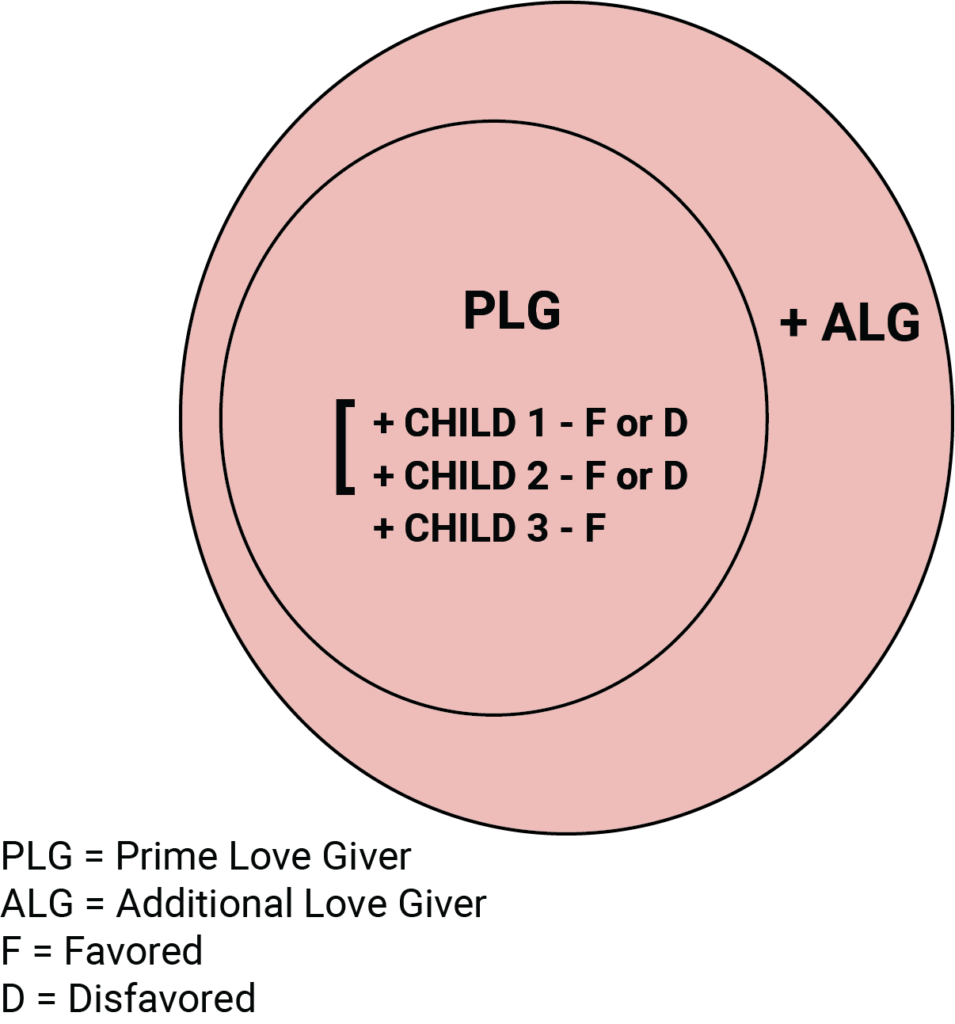
DOLF is based on the Emotional foundation we call the Mind of a Child, where ALL interactions among the children are geared toward determining whether any of them will become Favored or Disfavored by their PLG. Of the first two children, the one with the Favored personality and stronger connection with the PLG turns out gentle, mild-tempered, trusting and socially pleasing, while the one with the Disfavored personality has a weaker alliance with this prime Emotional parent. This Disfavored child struggles with more Anxiety, Depression and Anger and presents as more difficult for parents and others to manage behaviorally. Favored and Disfavored personalities and behavior do NOT follow birth order. They depend only the Favoritism that parents, especially, the PLG, feels in their hearts toward their children.
We should always remember that this Favoritism dynamic does NOT follow the visible differences that WE may see or judge about the siblings from our perspective, such as age, sex, intelligence, attractiveness physical ability or behavior. In the contrasting Emotional world of the Mind of a Child, competition with the next born sibling is the only paramount preoccupation. Inside this world, ALL siblings are equal because children give NO consideration whatsoever to ANY of the differences that we see from the outside such as age, sex or even ability/handicap. The siblings in each grouping are all only and exclusively fighting for the same cause of WINNING over the LOVE of their PLG.
So the short answer to the question about the personalities and behavioral adjustments of the siblings after the third or fourth is that the pattern of groupings remains exactly the same because all the rules governing the children’s interactions are rigid and immutable. As shown in the diagrams below the answer is that ALL SIBLINGS CLUSTER INTO GROUPS OF TWOS AND THREES AND COMPETE ONLY AND EXCLUSIVELY WITHIN THEIR OWN GROUPING OR CLUSTER, and this is a dynamic that lasts for the entire life of the family.
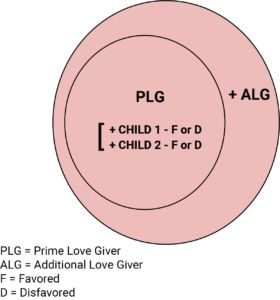
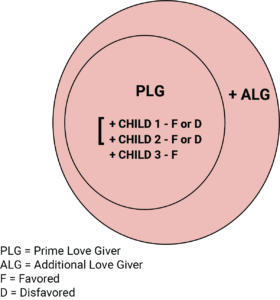
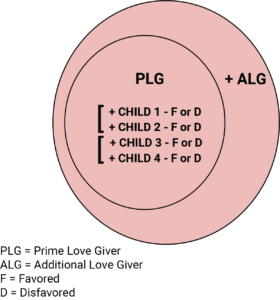
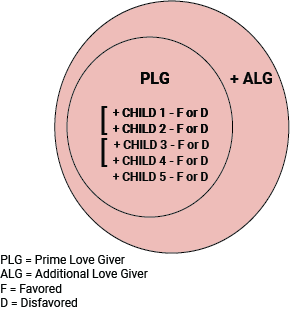
Each cluster is completely separate and operates on its own. Each child instinctively recognizes the siblings who are close in age to themselves and competes only within their own cluster. For example, as per the third diagram of four siblings, Child 1 competes only with their immediately younger sibling, Child 2, and does NOT compete with any of the siblings in the lower age cluster of Child 3 & 4. As per the last diagram, Child 5 may either join the second grouping to assume a Favored or Disfavored position, or may function on her/his own as an independent. If they join the group above, they run the risk of becoming Disfavored as a member of that grouping.
As mentioned in the blogs about 3 children, an important dynamic to look out for is if one of the two older children appears to be in conflict with, or is “picking on” the third, baby of the family. Although this is merely a decoy, as explained in other blogs about 3-child families, it is also a warning for parents to intervene. It reflects the serious discontent of this older child with their Disfavored position in their own cluster with their immediate rival, whether Child 1 or 2. As per the DOLF therapy protocol, the problem is treated by re-focusing attention onto this Disfavored child, whether in the first or middle position, in comparison with their Favored rival. However, if the Disfavored older sibling from Cluster 1 chooses to pick on Child 3, 4 or a younger one, the teasing and torment of this unfortunate younger sibling will be relentless. Moreover, surprisingly to us, if there are younger siblings, they are likely to be recruited too to help perpetuate the torment of the victimized sibling. My personal observations indicate that once the fourth child is born, an unfortunate Child 3 or younger one who is thus singled out will continue to be targeted by the Disfavored sibling of the older group, and any other siblings who are available will likely be recruited to form a small “gang”. This is an example of how sibling-to-sibling aggression can become a powerful force that can threaten the mental health of one child, and should handled by serious parental intervention as soon as it is noticed. (See the blog titled “When Siblings Gang Up”)
In multiple sibling families, there is often a problem of babysitting because of the need of parents to at times leave an older child in charge of younger ones. The main rule here is NOT to leave one child in charge of another who belongs to the same cluster. In other words, parents should NOT leave a disgruntled Disfavored child in charge of a younger one who is Favored and whom the older child can see as a scapegoat. The reason for this is that siblings who belong to the same cluster are always natural competitors and there will always be at least one in every grouping who feels Disfavored and one who feels Favored. Parents should be aware that an older child may always find babysitting an opportunity to take advantage of their younger next born, more naive and vulnerable sibling. In truth, though often necessary, babysitting with no adult present is a frightening situation for all children concerned, and is highly resented by both the Favored and Disfavored siblings.
In my book They Love You, They Love Me Not, The Truth About the Family Favorite and Sibling Rivalry, multi-sibling relationships in a family (unbroken by divorce or blending) are illustrated based in the book titled: The Kennedys, an American family. The family consisted of nine siblings whose historical biography is documented in some depth because the second son, John Kennedy, became the 35th president of the United States. Upon close scrutiny of the personalities as they are described, four groups of twos and threes emerge, with positive characteristics attributed to Joseph, Kathleen, Patricia and Edward as the four Favored children in their groupings, while John, Rosemary, Eunice, Robert and Jean display relatively negative personality traits as the Disfavored ones. It also becomes apparent that their father, Joseph Kennedy Senior, was the Prime Love Giving parent while their mother, Rose Kennedy, was the Additional Love Giving parent:
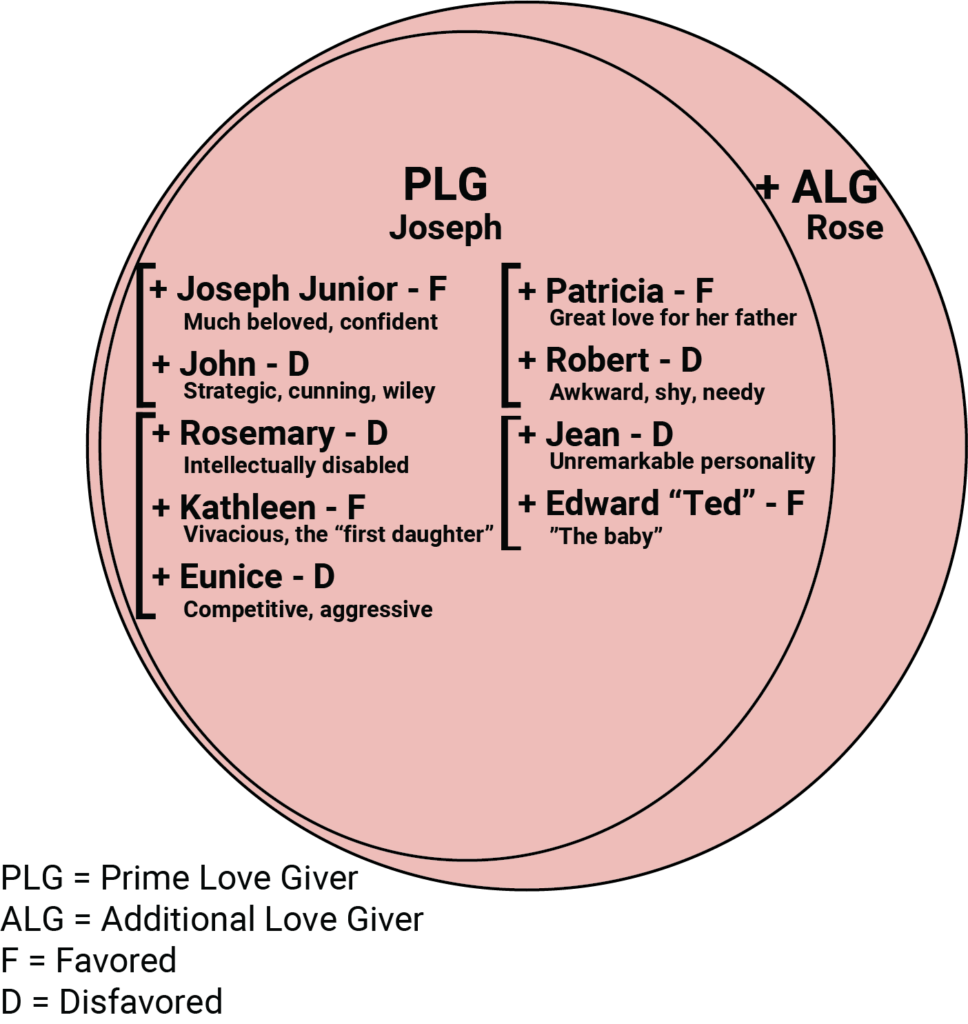
The DOLF sequence in the family turns out as FD, DFD, FD, DF. The only uncertain position is Eunice, who is placed in Cluster 2 with Rosemary and Kathleen. Not enough is known about the family dynamics to make the judgment about whether Eunice fits into Cluster 2 or 3. However objectively, she seems to fit better into Cluster 2, since she is closer to Kathleen in age than to Patricia in the younger cluster. As usual, gender is not a consideration, but in her case she seems to fit here better because of her age and also because she is of the same sex as both her older adjacent siblings.
Besides the famous Kennedy family, the very first inspiration for my DOLF Theory in families with more than three children comes from my father’s family which also consisted of nine siblings. Once I observed the differences between my own two children and other families with 3, 4 and 5, I confirmed my thoughts about Favoritism by looking closely at these aunts and uncles of mine. Although they were dispersed throughout many countries, their Favored and Disfavored positions became clear to me through family lore, as well as through my own personal, though sometimes brief experiences with all of them except for the second one, who died before I was born. Their particular combination was FD, FDD, DF, FD. My father was born third from last or 7th, and Favored. In a positive twist of fate, Child 3 of this series, a Favored female, became my grandmother. She married young and had 4 children of her own, and it happened that my father, Child 7 of the original series, married her eldest daughter, ten years younger than himself. So Child 3 of the nine gave her first daughter to her brother, and this first daughter of his older sister became my mother. My parents had three children of which I was the middle one. This made my grandmother my aunt (from my father’s side); my father, who was my mother’s uncle was my second uncle from my mother’s side, and my mother was my cousin!
Another example of a multiple, seven-child family are the descendants of Child 8, a female from my father’s family. These seven siblings are my cousins and I know them all well because we have had the pleasure of interacting over the years. Their sequence in terms of Favoritism is DF, DDF, DF and their mother, Child 8 was their strong PLG. In personality development there is only one small anomaly in that Child 2, a very warm Favored woman, was very close, caring and mothering toward her little sister, Child 6. While Child 6 is Disfavored in her own cluster with her last positioned younger sibling, we can speculate that the loving influence of the older daughter toward this younger daughter made the little one’s character somewhat more gentle and caring than she might have otherwise become as a Disfavored child in her own cluster. This seems to be the case since, in speaking with this female cousin, although she is a very fine, caring and loving person herself, she did once confide to me her feeling that her next born sibling, the youngest male and baby of the family, had been the recipient of more LOVE than she was, confirming she did feel resentment toward him and felt that he had been treated better than her.
When DOLF Theory is applied to family dynamics, figuring out the clusters becomes a matter of routine. As per DOLF, if one can take into account the feelings of the parents, especially after closely viewing the children’s personalities and behaviors, the answers to most of the questions about their modes of self-expression and interactions soon become abundantly clear. An important point is that Favoritism is a reality, and is, more often than not, a problem in EVERY family. Favoritism and its ensuing conflict is a problem that no human can escape. It is for this reason that DOLF instructs us that such intrafamilial strife is nothing to be ashamed of! Rather, we should consider that Favoritism and the human competitive spirit to achieve the most in any endeavor compared with a rival is “written into our DNA”, and can either be enhanced and encouraged, or beaten down and penalized. The plain fact that comes to light in this treatise is that we are ALL vitally involved in this same struggle, and that humankind will probably NEVER be able to completely circumvent the Favoritism paradigm. Referring back to the blog series about Creation, even DOLF itself is NOT a complete remedy for the problem of developing Favored vs. Disfavored characteristics in all our children because of the infinite demand of every human being to be best loved and appreciated. Yet the DOLF method leads us to conclude that the Favoritism and Sibling Rivalry model can be moderated if the prescribed treatment regime of modifying the DISTRIBUTION OF LOVE is followed by the PLG. For even though it is a basic feature of human nature, DOLF teaches us that our favoritistic tendencies can be overcome in some measure by our awareness and attentiveness to our own reactions and feelings toward our children, at the same time as it sensitizes us to the enduring undercurrent of Emotions on all our worlds.
